Kris Oldland, Editor-in-Chief, Field Service News is joined by Amit Jain, Chief Product Officer, ServiceMax as the two discuss the role of asset data in anticipation of a major research study undertaken by Field Service News Research in partnership...
ARCHIVE FOR THE ‘digital-transformation’ CATEGORY
Feb 11, 2022 • Features • Digital Transformation • IoT • servicemax • Servitization • Sustainability • Asset Data • amit jain
Kris Oldland, Editor-in-Chief, Field Service News is joined by Amit Jain, Chief Product Officer, ServiceMax as the two discuss the role of asset data in anticipation of a major research study undertaken by Field Service News Research in partnership with ServiceMax.
In this last excerpt from that interview, the two discuss why asset data needs to be viewed on both the macro and micro level and we need to be able to break down granular, component-level data as much as we need fleet data across the whole install base.
If you are an FSN Premium subscriber you can access the full interview now on the button below. Alternatively, if you are yet to subscribe or are on our forever-free subscription you can join FSN Premium on the button below and get full access to the entire FSN Premium resource library.
Read the Executive Briefing Report based on the findings of the latest Field Service News Research Project:
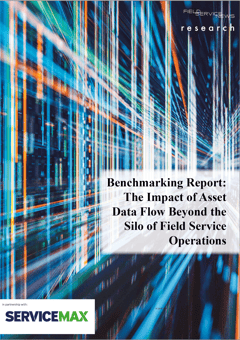 If you are a Field Service News subscriber on either our free-forever FSN Standard subscription tier or our Premium Subscription tier you can access the full 18-page report written by Field Service News, Editor-in-Chief, Kris Oldland that offers in-depth analysis of the research project now on the button below.
If you are a Field Service News subscriber on either our free-forever FSN Standard subscription tier or our Premium Subscription tier you can access the full 18-page report written by Field Service News, Editor-in-Chief, Kris Oldland that offers in-depth analysis of the research project now on the button below.
If you are not yet a subscriber to Field Service News but would like to subscribe and gain access to this report instantly, click the button to visit a dedicated registration page for our complimentary sponsored subscription tier and that will give you instant access to this paper and a number of other assets currently available to subscribers on this tier
 Data usage note: By accessing this content you consent to the contact details submitted when you registered as a subscriber to fieldservicenews.com to be shared with the listed sponsor of this premium content, ServiceMax who may contact you for legitimate business reasons to discuss the content of this study.
Data usage note: By accessing this content you consent to the contact details submitted when you registered as a subscriber to fieldservicenews.com to be shared with the listed sponsor of this premium content, ServiceMax who may contact you for legitimate business reasons to discuss the content of this study.
Feb 10, 2022 • News • Digital Transformation • IoT • servicenow
Field Service News and ServiceNow have recently partnered on an exclusive new white paper "Understanding The Next Phase Of IoT Evolution" and as part of the planning for this paper Kris Oldland, Editor-in-Chief, Field Service News was joined on the...
Field Service News and ServiceNow have recently partnered on an exclusive new white paper "Understanding The Next Phase Of IoT Evolution" and as part of the planning for this paper Kris Oldland, Editor-in-Chief, Field Service News was joined on the Field Service News Digital Symposium by Tasker Generes and Bulent Cinarkaya of ServiceNow to discuss how IoT can improve asset management, workforce management and drive customer success.
Here the group discuss how the conversation of digital transformation and IoT in particular needs to be understood as one that is a strategic business discussion and not a technology-focused one.
If you are an FSN Premium subscriber you can access the full interview now on the button below. Alternatively, if you are yet to subscribe or are on our forever-free subscription you can join FSN Premium on the button below and get full access to the entire FSN Premium resource library.
Read this latest Field Service News Paper Now!
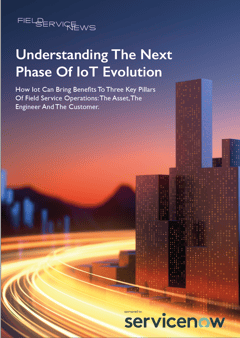 If you are a Field Service News subscriber on either our free-forever FSN Standard subscription tier or our Premium Subscription tier you can access this exclusive Field Service News white paper written by Field Service News, Editor-in-Chief, Kris Oldland on the button below.
If you are a Field Service News subscriber on either our free-forever FSN Standard subscription tier or our Premium Subscription tier you can access this exclusive Field Service News white paper written by Field Service News, Editor-in-Chief, Kris Oldland on the button below.
If you are not yet a subscriber to Field Service News but would like to subscribe and gain access to this report instantly, click the button to visit a dedicated registration page for our complimentary sponsored subscription tier and that will give you instant access to this paper and a number of other assets currently available to subscribers on this tier.
 Data usage note: By accessing this content you consent to the contact details submitted when you registered as a subscriber to fieldservicenews.com to be shared with the listed sponsor of this premium content, ServiceNow who may contact you for legitimate business reasons to discuss the content of this paper.
Data usage note: By accessing this content you consent to the contact details submitted when you registered as a subscriber to fieldservicenews.com to be shared with the listed sponsor of this premium content, ServiceNow who may contact you for legitimate business reasons to discuss the content of this paper.
Further Reading:
- Read more about Digital Transformation @ https://www.fieldservicenews.com/blog/tag/digital-transformation
- Read more about IoT and Field Service @ https://www.fieldservicenews.com/hs-search-results?term=IoT
- Find out more about how ServiceNow is working with Field Service Companies @ https://www.servicenow.com/
- Follow ServiceNow on Twitter @ https://twitter.com/ServiceNowUKI
- Read more about Service Strategy and Design @ https://www.fieldservicenews.com/blog/tag/service-innovation-and-design
- Watch more in-depth interviews in the Field Service News Digital Symposium @ https://www.fieldservicenews.com/digital-symposium
Feb 09, 2022 • Features • Digital Transformation • IoT • servicemax • Servitization • Sustainability • Asset Data • amit jain
Kris Oldland, Editor-in-Chief, Field Service News is joined by Amit Jain, Chief Product Officer, ServiceMax as the two discuss the role of asset data in anticipation of a major research study undertaken by Field Service News Research in partnership...
Kris Oldland, Editor-in-Chief, Field Service News is joined by Amit Jain, Chief Product Officer, ServiceMax as the two discuss the role of asset data in anticipation of a major research study undertaken by Field Service News Research in partnership with ServiceMax.
In this excerpt from the discussion, the two discuss how proper use and utilisation of asset data can play an important role in establishing the circular economy and help us push towards a more sustainable future for our industry.
If you are an FSN Premium subscriber you can access the full interview now on the button below. Alternatively, if you are yet to subscribe or are on our forever-free subscription you can join FSN Premium on the button below and get full access to the entire FSN Premium resource library.
Read the Executive Briefing Report based on the findings of the latest Field Service News Research Project:
 If you are a Field Service News subscriber on either our free-forever FSN Standard subscription tier or our Premium Subscription tier you can access the full 18-page report written by Field Service News, Editor-in-Chief, Kris Oldland that offers in-depth analysis of the research project now on the button below.
If you are a Field Service News subscriber on either our free-forever FSN Standard subscription tier or our Premium Subscription tier you can access the full 18-page report written by Field Service News, Editor-in-Chief, Kris Oldland that offers in-depth analysis of the research project now on the button below.
If you are not yet a subscriber to Field Service News but would like to subscribe and gain access to this report instantly, click the button to visit a dedicated registration page for our complimentary sponsored subscription tier and that will give you instant access to this paper and a number of other assets currently available to subscribers on this tier
 Data usage note: By accessing this content you consent to the contact details submitted when you registered as a subscriber to fieldservicenews.com to be shared with the listed sponsor of this premium content, ServiceMax who may contact you for legitimate business reasons to discuss the content of this study.
Data usage note: By accessing this content you consent to the contact details submitted when you registered as a subscriber to fieldservicenews.com to be shared with the listed sponsor of this premium content, ServiceMax who may contact you for legitimate business reasons to discuss the content of this study.
Feb 08, 2022 • News • Digital Transformation • IoT • servicenow
Field Service News and ServiceNow have recently partnered on an exclusive new white paper "Understanding The Next Phase Of IoT Evolution" and as part of the planning for this paper Kris Oldland, Editor-in-Chief, Field Service News was joined on the...
Field Service News and ServiceNow have recently partnered on an exclusive new white paper "Understanding The Next Phase Of IoT Evolution" and as part of the planning for this paper Kris Oldland, Editor-in-Chief, Field Service News was joined on the Field Service News Digital Symposium by Tasker Generes and Bulent Cinarkaya of ServiceNow to discuss how IoT can improve asset management, workforce management and drive customer success.
In this part of the conversation the three look at the potential value of asset data beyond the confines of field service operations and whether it can bring greater impact to an organisation as a whole if the silos of different departments are overcome.
If you are an FSN Premium subscriber you can access the full interview now on the button below. Alternatively, if you are yet to subscribe or are on our forever-free subscription you can join FSN Premium on the button below and get full access to the entire FSN Premium resource library.
Read this latest Field Service News Paper Now!
 If you are a Field Service News subscriber on either our free-forever FSN Standard subscription tier or our Premium Subscription tier you can access this exclusive Field Service News white paper written by Field Service News, Editor-in-Chief, Kris Oldland on the button below.
If you are a Field Service News subscriber on either our free-forever FSN Standard subscription tier or our Premium Subscription tier you can access this exclusive Field Service News white paper written by Field Service News, Editor-in-Chief, Kris Oldland on the button below.
If you are not yet a subscriber to Field Service News but would like to subscribe and gain access to this report instantly, click the button to visit a dedicated registration page for our complimentary sponsored subscription tier and that will give you instant access to this paper and a number of other assets currently available to subscribers on this tier.
 Data usage note: By accessing this content you consent to the contact details submitted when you registered as a subscriber to fieldservicenews.com to be shared with the listed sponsor of this premium content, ServiceNow who may contact you for legitimate business reasons to discuss the content of this paper.
Data usage note: By accessing this content you consent to the contact details submitted when you registered as a subscriber to fieldservicenews.com to be shared with the listed sponsor of this premium content, ServiceNow who may contact you for legitimate business reasons to discuss the content of this paper.
Further Reading:
- Read more about Digital Transformation @ https://www.fieldservicenews.com/blog/tag/digital-transformation
- Read more about IoT and Field Service @ https://www.fieldservicenews.com/hs-search-results?term=IoT
- Find out more about how ServiceNow is working with Field Service Companies @ https://www.servicenow.com/
- Follow ServiceNow on Twitter @ https://twitter.com/ServiceNowUKI
- Read more about Service Strategy and Design @ https://www.fieldservicenews.com/blog/tag/service-innovation-and-design
- Watch more in-depth interviews in the Field Service News Digital Symposium @ https://www.fieldservicenews.com/digital-symposium
Feb 07, 2022 • News • Digital Transformation • IoT • servicenow
There are several areas in which connected field service can change asset management for field service organizations in the not too distant future. In this first feature in a series of excerpts from the latest white paper from Field Service News, we...
There are several areas in which connected field service can change asset management for field service organizations in the not too distant future. In this first feature in a series of excerpts from the latest white paper from Field Service News, we shall explore some of the potential benefits of IoT enabled assets...
Asset Self-Monitoring:
The traditional paradigm of field service has relied on an asset breaking down, a service request being submitted, an engineer being dispatched, and in an ideal world, resolving the issue in a first-time fix. Even when this process is undertaken with optimum efficiency, when everything goes perfectly, there is still a significant amount of downtime between asset failure and issue resolution.
Of course, many field service organizations introduced planned preventative maintenance (PPM) to help their customers avoid unnecessary downtime. However, helping in this first issue of reducing unnecessary downtime, a PPM based-approach results in unnecessary service calls, which can become an additional cost-line either for the service provider or the customer.
Despite PPM being often viewed as an improvement on the break-fix approach, the truth is that depending on the importance of the asset in the customers own revenue generation, either a break-fix or PPM approach may have been the best option within a service portfolio. However, ultimately neither are optimum.
In a world of connected field service, we can move beyond PPM and introduce true pro-active maintenance into a service portfolio.
To illustrate this, let us take a simple example of a hot drink vending machine with a failing boiling mechanism.
In the old break-fix model, the issue would be eventually noticed by a customer, who would report their cup of hot morning coffee wasn’t piping hot. Eventually, a customer complaint would lead to the arrangement of a service call; the vending machine would be turned off, so no longer generating any revenue until an engineer could be sent to resolve the issue.
"IoT offers a far greater workflow by allowing the asset itself to, in effect, undertake that inspection requirement and then the service company only need schedule necessary maintenance as and when it is required..."
In a PPM environment, this fault may be picked up before it was reported by a customer, which could help mitigate unplanned downtime. However, it is not cost-effective to send a technician skilled enough to resolve the issue on an inspection call.
The alternative is for the field service organization to commit to sending a skilled resource to a series of calls where their skill-set is not being used to maximum effect (i.e. those calls where there is no fault to be resolved). Yet, of course, there is no benefit to the customer to pay for one set of technicians to undertake inspection calls if they cannot resolve any issues they may find.
While offering an enhanced layer of service to the customer, such an approach ultimately results in a bloated cost base for the service provider. However, IoT offers a far greater workflow by allowing the asset itself to, in effect, undertake that inspection requirement and then the service company only need schedule necessary maintenance as and when it is required.
In the example of our vending machine, the machine could have a sensor that monitors the temperature of the water when it reaches boiling point in the delivery of the coffee. If the average temperature of the water begins to hit outside of an acceptable parameter that indicates an imminent failure, with an IoT connected asset, an alert could be triggered automatically.
What Comes Next?
The above example allows us to see how even in just a very simple situation how having just one data feed on an asset could have a significant benefit for both service provider and their customer alike. The customer benefits from proactive maintenance that can be primarily scheduled in off-peak hours where the impact of downtime is minimized. The service provider has a considerable reduction in costs as truck-rolls are minimized to effective work.
However, we could also expand on this simple example in several ways to further leverage this IoT data feed to enhance the service delivery process.
Connection to Engineer and Parts Scheduling
The most obvious first step would be to schedule an engineer directly if sensor data crosses a threshold to trigger an action within an organization’s field service management solution. The reality is that this chain of processes is precisely the type of mundane process automation that Robotic Process Automation (RPA) is designed for.
The rules could be fairly straightforward to make this happen. If the water temperature moves outside of acceptable parameters by two degrees, then historic data can interpret that this is an indication of failure. To keep the example simple, let us assume a direct correlation between the degrees outside the defined parameters and the mean-time-to-failure. In a real-life scenario, the modelling may be more complex, but for clarity of the concept, let us just assume that as the water falls a couple of degrees below the accepted parameters, this is an indication of the asset falling within the next three weeks.
This provides us with a fairly routine set of requirements that we would want to automate. By leveraging the IoT asset data and data within our workforce management tools, we can begin to map this out reasonably simply.
- If the water temperature falls outside of standard parameters by 2 degrees, an engineer needs to be scheduled to provide a proactive repair within three weeks. This is asset data provided by IoT.
- Identify potential fault cause ahead of the engineer visit. This is where the asset data can be filtered through a knowledge bank via Artificial Intelligence (AI).
- Identify which technicians are local to this area, have the required skills-set and availability within the timeframe. This is workforce data held within the relevant system of record.
- Identify potential spare parts required and arrange for them to be delivered to the client site, engineer or drop off location ahead of a service call to allow the best opportunity for a first-time fix. This is a trigger based on the output of the AI triage being fed into either a dedicated parts and inventory or FSM solution.
All of this can be done and fed either directly to the customer themselves or potentially a customer service agent who can contact the customer with a list of potential solutions and times that a field technician can be dispatched to resolve the problem in the absolute minimum impact to the customer's business.
Facilitation of Self-Service Solutions
The above allows us to see how the use of RPA being fed by IoT data with a layer of AI can dramatically change how we approach field service delivery. However, in the above example, we could even take this a step further and look to utilize the same tools to facilitate a self-service approach to maintenance.
Let us for a moment consider once more the vending machine in our example and take into account another potential development into this mix, modular design. If the customer could easily replace the failing part, the process could be slightly reworked to allow for self-service.
The exact same processes could be leveraged to facilitate such an approach.
However, in the final stage of this process, the customer being contacted directly via automation or via a customer service agent could be given the opportunity to undertake the maintenance themselves.
"The question of utmost importance in this instance is what is in it for the customer? The answer would be in two of the most precious commodities of the twenty-first century; time and convenience..."
Clear instructions on the maintenance could be sent to the customer via the knowledge base digitally, and the required parts could be identified and dispatched to the customer directly.
Suppose we include a remote service support solution within the technology stack of the field service provider. In that case, the customer could even be given a link for real-time support as they undertake the maintenance. The question of utmost importance in this instance is what is in it for the customer? The answer would be in 2 of the most precious commodities of the 21st century; time and convenience.
Self-service allows the customer to have their asset up and running without the wait for an available engineer. Self-service allows the customer to ensure the maintenance is undertaken when their own customers are not present.
Of course, such an approach may not be suitable for every situation. However, it is certainly something that is capturing the attention of many in the field service sector. Such an approach is made infinitely more seamless as we look to build upon the current use of IoT-based asset data.
The Question of Data Ownership
While there are undoubtedly as we have seen, many opportunities for IoT to drive consistent improvement in asset management, the one area we must also address in this conversation is the challenge of data ownership.
This has been something of a critical and often contentious topic of conversation as we move into a new era of field service and indeed business at large that is driven by data - the great resource of the twenty-first century.
The conversation is particularly complex - does data generated by an asset fall within the protection of patents so remain with the manufacturer? Or is the data created through use so generated by the customer and as such the output of their own work and something they own?
It is one of the big discussions that we will collectively need to resolve as we move ever onwards in our data-driven digital transformation journey. Yet, in some ways a focus on the granular debate of data ownership should and must make way for the macro discussion of how we can leverage the data for the benefit of the customer.
As Tasker Generes, Global Head – Strategy and Information, ServiceNow explained on the Field Service News Digital Symposium “The question of who owns what data is a thorny issue that we are currently in the middle of trying to really get to grips with as an industry.
“However, I believe the discussion ultimately comes down to the fact that customers want it to be really easy to engage with any company they are doing business with. Frankly, if it is not easy to engage they are going to leave because they have options. When you are looking at data, it is really necessary for those who need to know to understand the inner workings of what goes wrong, but customers more often than not just want the service or product they use to work.
"We have to understand as an industry that going forward this market is massively evolving. These changes we are moving through currently will bring with them complex questions over privacy, data and ownership and data stewardship..."
- Tasker Generes, ServiceNow
“The real challenge is determining what is and what isn’t needed within the data set. It is identifying how do we really become proactive and help prevent the issue. In order to do this we cannot look at IoT as a standalone; it has to be viewed with additional context of other variables relevant to the specific situation. It is imperative that the service provider is able to get the data into a position where it offers actionable insight. IoT can offer us so much data, but to be able to have those brilliant insights, it has to be tied to the action.
“We have to understand as an industry that going forward this market is massively evolving. These changes we are moving through currently will bring with them complex questions over privacy, data and ownership and data stewardship. With Industry 4.0 and the current digital trends, access to data is going to be required to deliver the customer the great service they expect.
“However, as service providers, we now must understand that customers whether it is in the B2B or consumer verticals, don’t want to be ‘on the grid’ and let people learn everything about them through their data.
“So the critical question service providers must consider is ‘how do we create the ability to learn from the data in a set rather than for the individual?'”
Read this latest Field Service News Paper Now!
 If you are a Field Service News subscriber on either our free-forever FSN Standard subscription tier or our Premium Subscription tier you can access this exclusive Field Service News white paper written by Field Service News, Editor-in-Chief, Kris Oldland on the button below.
If you are a Field Service News subscriber on either our free-forever FSN Standard subscription tier or our Premium Subscription tier you can access this exclusive Field Service News white paper written by Field Service News, Editor-in-Chief, Kris Oldland on the button below.
If you are not yet a subscriber to Field Service News but would like to subscribe and gain access to this report instantly, click the button to visit a dedicated registration page for our complimentary sponsored subscription tier and that will give you instant access to this paper and a number of other assets currently available to subscribers on this tier.
 Data usage note: By accessing this content you consent to the contact details submitted when you registered as a subscriber to fieldservicenews.com to be shared with the listed sponsor of this premium content, ServiceNow who may contact you for legitimate business reasons to discuss the content of this paper.
Data usage note: By accessing this content you consent to the contact details submitted when you registered as a subscriber to fieldservicenews.com to be shared with the listed sponsor of this premium content, ServiceNow who may contact you for legitimate business reasons to discuss the content of this paper.
Further Reading:
- Read more about Digital Transformation @ www.fieldservicenews.com/digital-transformation
- Read more about IoT and Field Service @ www.fieldservicenews.com/IoT
- Find out more about how ServiceNow is working with Field Service Companies @ www.servicenow.com
- Follow ServiceNow on Twitter @ twitter.com/ServiceNowUKI
- Read more about Service Strategy and Design @ www.fieldservicenews.com/service-innovation-and-design
Feb 07, 2022 • Features • Digital Transformation • IoT • servicemax • Servitization • Asset Data • amit jain
Kris Oldland, Editor-in-Chief, Field Service News is joined by Amit Jain, Chief Product Officer, ServiceMax as the two discuss the role of asset data in anticipation of a major research study undertaken by Field Service News Research in partnership...
Kris Oldland, Editor-in-Chief, Field Service News is joined by Amit Jain, Chief Product Officer, ServiceMax as the two discuss the role of asset data in anticipation of a major research study undertaken by Field Service News Research in partnership with ServiceMax.
In this part of that hour-long conversation, the two discuss whether they believe there will be a clear correlation between the prevalence of asset data being shared across different business units and the likelihood of an organisation adopting a servitized business model.
If you are an FSN Premium subscriber you can access the full interview now on the button below. Alternatively, if you are yet to subscribe or are on our forever-free subscription you can join FSN Premium on the button below and get full access to the entire FSN Premium resource library.
Read the Executive Briefing Report based on the findings of the latest Field Service News Research Project:
 If you are a Field Service News subscriber on either our free-forever FSN Standard subscription tier or our Premium Subscription tier you can access the full 18-page report written by Field Service News, Editor-in-Chief, Kris Oldland that offers in-depth analysis of the research project now on the button below.
If you are a Field Service News subscriber on either our free-forever FSN Standard subscription tier or our Premium Subscription tier you can access the full 18-page report written by Field Service News, Editor-in-Chief, Kris Oldland that offers in-depth analysis of the research project now on the button below.
If you are not yet a subscriber to Field Service News but would like to subscribe and gain access to this report instantly, click the button to visit a dedicated registration page for our complimentary sponsored subscription tier and that will give you instant access to this paper and a number of other assets currently available to subscribers on this tier
 Data usage note: By accessing this content you consent to the contact details submitted when you registered as a subscriber to fieldservicenews.com to be shared with the listed sponsor of this premium content, ServiceMax who may contact you for legitimate business reasons to discuss the content of this study.
Data usage note: By accessing this content you consent to the contact details submitted when you registered as a subscriber to fieldservicenews.com to be shared with the listed sponsor of this premium content, ServiceMax who may contact you for legitimate business reasons to discuss the content of this study.
Feb 04, 2022 • Features • White Paper • Digital Transformation • Data Management • customer experience • CareAR
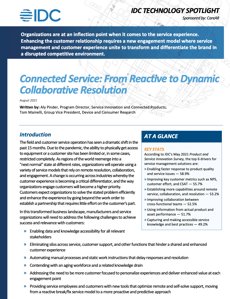
This feature is just one short excerpt from a recent white paper published by CareAR.
www.fieldservicenews.com subscribers can read the full white paper now by hitting the button below.
If you are yet to subscribe you can do so for free by hitting the button and registering for our complimentary subscription tier FSN Standard on a dedicated page that provides you instant access to this white paper PLUS you will also be able to access our monthly selection of premium resources as soo as you are registered.

Data usage note: By accessing this content you consent to the contact details submitted when you registered as a subscriber to fieldservicenews.com to be shared with the listed sponsor of this premium content CareAR who may contact you for legitimate business reasons to discuss the content of this white paper, as per the terms and conditions of your subscription agreement which you opted into in line with GDPR regulations and is an ongoing condition of subscription.
Manufacturers and service organizations need to manage various priorities to ensure they can survive, thrive, and excel in a competitive environment where customer expectations continue to rise.
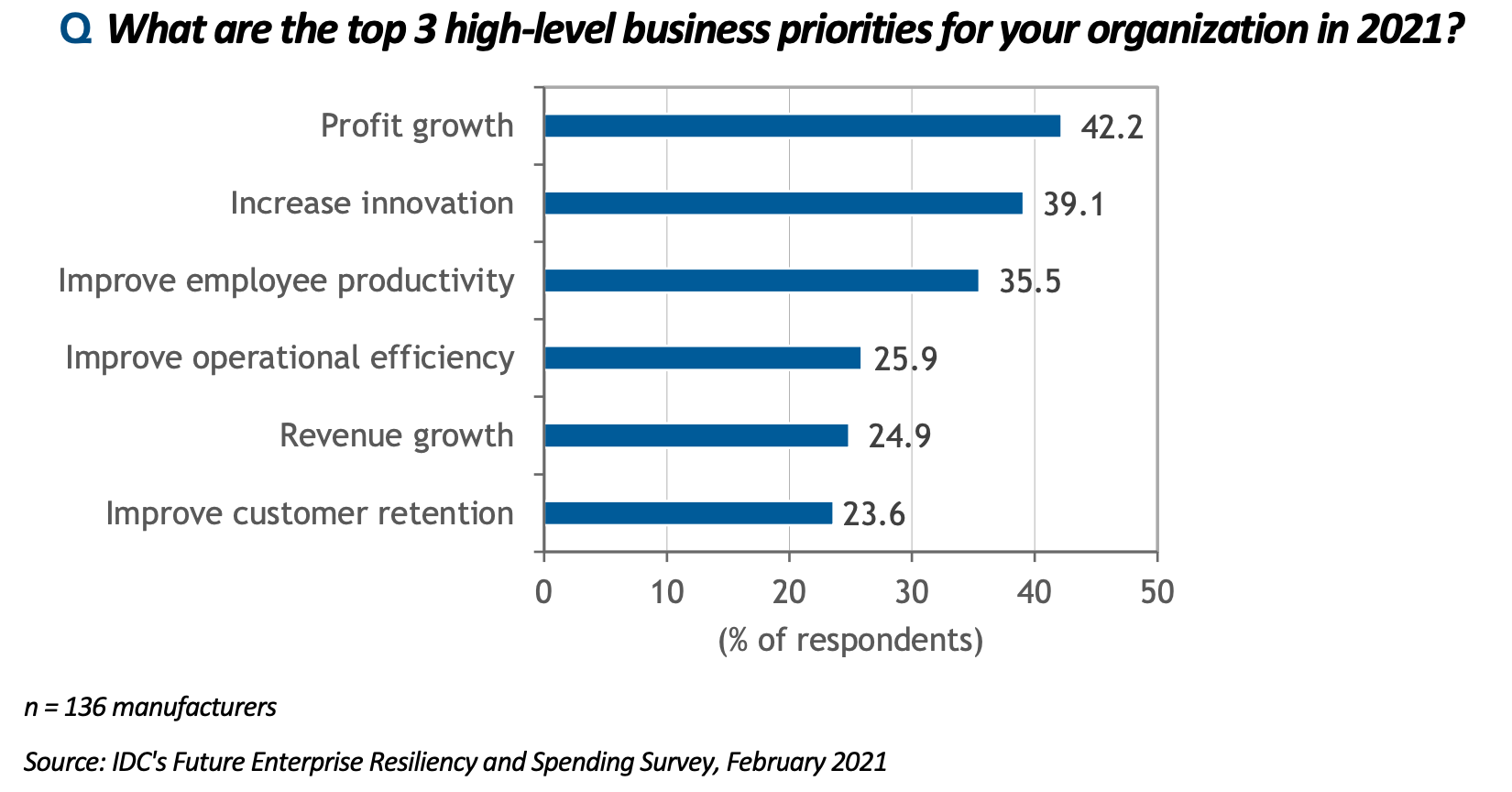
BENEFITS
Service management with field technicians — and directly with customers — has long been held back by a reactive break/fix model. In this model, customers have to notify the service organization of a failure or a break. The field service team then must attempt to solve the issue with limited information gleaned from the customer or historical data from the last service visit. This process typically involves dispatching a service technician or engineer to a customer site to validate a diagnosis, often leading to a secondary or tertiary service call. Real-time visibility into the product or asset with detailed collaborative capabilities can transform the service and customer experience.
The shift from reactive service models to proactive service experiences has an impact that transcends operational efficiency to enhance the customer relationship. Establishing an operating model where the customer and the service employee are at the heart of the service experience is transformative and can be a true industry differentiator. This framework establishes a new partnership of shared goals, outcomes, and experiences that optimize service and deliver new value.
Connected service insights are part of the innovative future for manufacturers and service organizations. A few of the most impactful benefits derived from this approach are:
- Having the right content and insights at the point of need, which speeds up service resolution and avoids the need to sift through irrelevant manuals and work instructions with reactive and proactive service interactions
-
Capturing and then sharing institutional knowledge, which minimizes the impact of an aging or retiring field and service workforce
-
Improving increased first-time fix and lower mean-time-to-resolution metrics, which enhances the customer experience through proactive support
-
Avoiding unnecessary truck rolls that impact fuel usage, emissions, and safety, which helps improve operations
-
Establishing an emotional and personalized bond between the service team and the customer through contextual awareness of the problem at hand, integration of a full view of the customer, and self-service experiences
TRENDS
Manufacturers and service organizations are racing to digitally transform their business operations to deliver a new experience to customers, enhancing both the brand and the engagement model. Competition has forced manufacturers and service organizations to rethink how they strengthen bonds with customers, which wasn't historically necessary as they owned the customer life cycle. In IDC's November 2020 COVID-19 Impact on IT Spending Survey, nearly half of manufacturers said they prioritize creating new digital products and services and now look to deliver digital-first customer experiences — 46.2% and 31.9%, respectively
Field Service News subscribers can access the full white paper sponsored by CareAR and written by Ali Pinder, Program Director, Service Innovation and Connected Products at IDC, and Tom Mainelli, IDC's Group Vice President, Device and Consumer Research, by clicking on the button below.
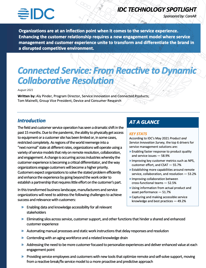
This feature is just one short excerpt from a recent white paper we published in partnership with Exel Computer Systems..
www.fieldservicenews.com subscribers can read the full white paper now by hitting the button below.
If you are yet to subscribe you can do so for free by hitting the button and registering for our complimentary subscription tier FSN Standard on a dedicated page that provides you instant access to this white paper PLUS you will also be able to access our monthly selection of premium resources as soo as you are registered.
 Data usage note: By accessing this content you consent to the contact details submitted when you registered as a subscriber to fieldservicenews.com to be shared with the listed sponsor of this premium content CareAR who may contact you for legitimate business reasons to discuss the content of this white paper, as per the terms and conditions of your subscription agreement which you opted into in line with GDPR regulations and is an ongoing condition of subscription.
Data usage note: By accessing this content you consent to the contact details submitted when you registered as a subscriber to fieldservicenews.com to be shared with the listed sponsor of this premium content CareAR who may contact you for legitimate business reasons to discuss the content of this white paper, as per the terms and conditions of your subscription agreement which you opted into in line with GDPR regulations and is an ongoing condition of subscription.
Further Reading:
- Read more about Digital Transformation @ www.fieldservicenews.com/digital-transformation
- Read more about Customer Experience @ www.fieldservicenews.com/customer+experience
- Learn more about CareAR @ carear.com
- Follow CareAR on Twitter @ twitter.com/carear_com
- Connect with CareAR on LinkedIn @ www.linkedin.com/carear/
Feb 04, 2022 • Features • Digital Transformation • IoT • servicemax • Asset Data • amit jain
Kris Oldland, Editor-in-Chief, Field Service News is joined by Amit Jain, Chief Product Officer, ServiceMax as the two discuss the role of asset data in anticipation of a major research study undertaken by Field Service News Research in partnership...
Kris Oldland, Editor-in-Chief, Field Service News is joined by Amit Jain, Chief Product Officer, ServiceMax as the two discuss the role of asset data in anticipation of a major research study undertaken by Field Service News Research in partnership with ServiceMax.
In this excerpt from the full discussion Jain outlines how by effectively leveraging asset data field service organisations can join the dots of customer, asset and engineer to drive optimal results and enhanced service delivery.
If you are an FSN Premium subscriber you can access the full interview now on the button below. Alternatively, if you are yet to subscribe or are on our forever-free subscription you can join FSN Premium on the button below and get full access to the entire FSN Premium resource library.
Read the Executive Briefing Report based on the findings of the latest Field Service News Research Project:
 If you are a Field Service News subscriber on either our free-forever FSN Standard subscription tier or our Premium Subscription tier you can access the full 18-page report written by Field Service News, Editor-in-Chief, Kris Oldland that offers in-depth analysis of the research project now on the button below.
If you are a Field Service News subscriber on either our free-forever FSN Standard subscription tier or our Premium Subscription tier you can access the full 18-page report written by Field Service News, Editor-in-Chief, Kris Oldland that offers in-depth analysis of the research project now on the button below.
If you are not yet a subscriber to Field Service News but would like to subscribe and gain access to this report instantly, click the button to visit a dedicated registration page for our complimentary sponsored subscription tier and that will give you instant access to this paper and a number of other assets currently available to subscribers on this tier
 Data usage note: By accessing this content you consent to the contact details submitted when you registered as a subscriber to fieldservicenews.com to be shared with the listed sponsor of this premium content, ServiceMax who may contact you for legitimate business reasons to discuss the content of this study.
Data usage note: By accessing this content you consent to the contact details submitted when you registered as a subscriber to fieldservicenews.com to be shared with the listed sponsor of this premium content, ServiceMax who may contact you for legitimate business reasons to discuss the content of this study.
Feb 03, 2022 • News • Digital Transformation • IoT • servicenow
Field Service News and ServiceNow have recently partnered on an exclusive new white paper "Understanding The Next Phase Of IoT Evolution" and as part of the planning for this paper Kris Oldland, Editor-in-Chief, Field Service News was joined on the...
Field Service News and ServiceNow have recently partnered on an exclusive new white paper "Understanding The Next Phase Of IoT Evolution" and as part of the planning for this paper Kris Oldland, Editor-in-Chief, Field Service News was joined on the Field Service News Digital Symposium by Tasker Generes and Bulent Cinarkaya of ServiceNow to discuss how IoT can improve asset management, workforce management and drive customer success.
In this excerpt from that discussion, the three discuss the importance of being able to process data in order to drive actionable insights that can drive improvements across the field service operation.
If you are an FSN Premium subscriber you can access the full interview now on the button below. Alternatively, if you are yet to subscribe or are on our forever-free subscription you can join FSN Premium on the button below and get full access to the entire FSN Premium resource library.
Read this latest Field Service News Paper Now!
 If you are a Field Service News subscriber on either our free-forever FSN Standard subscription tier or our Premium Subscription tier you can access this exclusive Field Service News white paper written by Field Service News, Editor-in-Chief, Kris Oldland on the button below.
If you are a Field Service News subscriber on either our free-forever FSN Standard subscription tier or our Premium Subscription tier you can access this exclusive Field Service News white paper written by Field Service News, Editor-in-Chief, Kris Oldland on the button below.
If you are not yet a subscriber to Field Service News but would like to subscribe and gain access to this report instantly, click the button to visit a dedicated registration page for our complimentary sponsored subscription tier and that will give you instant access to this paper and a number of other assets currently available to subscribers on this tier.
 Data usage note: By accessing this content you consent to the contact details submitted when you registered as a subscriber to fieldservicenews.com to be shared with the listed sponsor of this premium content, ServiceNow who may contact you for legitimate business reasons to discuss the content of this paper.
Data usage note: By accessing this content you consent to the contact details submitted when you registered as a subscriber to fieldservicenews.com to be shared with the listed sponsor of this premium content, ServiceNow who may contact you for legitimate business reasons to discuss the content of this paper.
Further Reading:
- Read more about Digital Transformation @ https://www.fieldservicenews.com/blog/tag/digital-transformation
- Read more about IoT and Field Service @ https://www.fieldservicenews.com/hs-search-results?term=IoT
- Find out more about how ServiceNow is working with Field Service Companies @ https://www.servicenow.com/
- Follow ServiceNow on Twitter @ https://twitter.com/ServiceNowUKI
- Read more about Service Strategy and Design @ https://www.fieldservicenews.com/blog/tag/service-innovation-and-design
- Watch more in-depth interviews in the Field Service News Digital Symposium @ https://www.fieldservicenews.com/digital-symposium







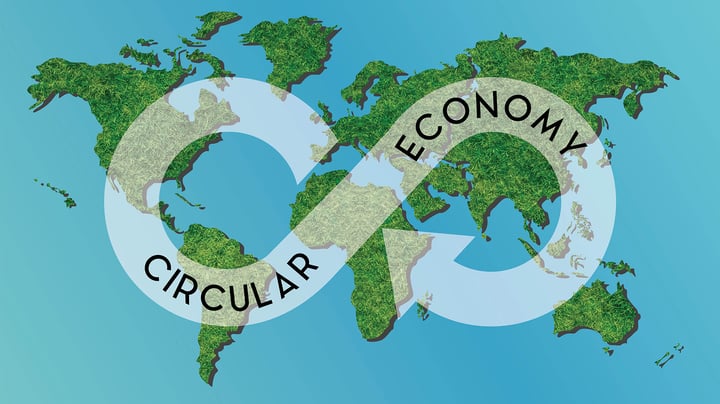














 Field Service News is published by 1927 Media Ltd, an independent publisher whose sole focus is on the field service sector. As such our entire resources are focused on helping drive the field service sector forwards and aiming to best serve our industry through honest, incisive and innovative media coverage of the global field service sector.
Field Service News is published by 1927 Media Ltd, an independent publisher whose sole focus is on the field service sector. As such our entire resources are focused on helping drive the field service sector forwards and aiming to best serve our industry through honest, incisive and innovative media coverage of the global field service sector.
Leave a Reply